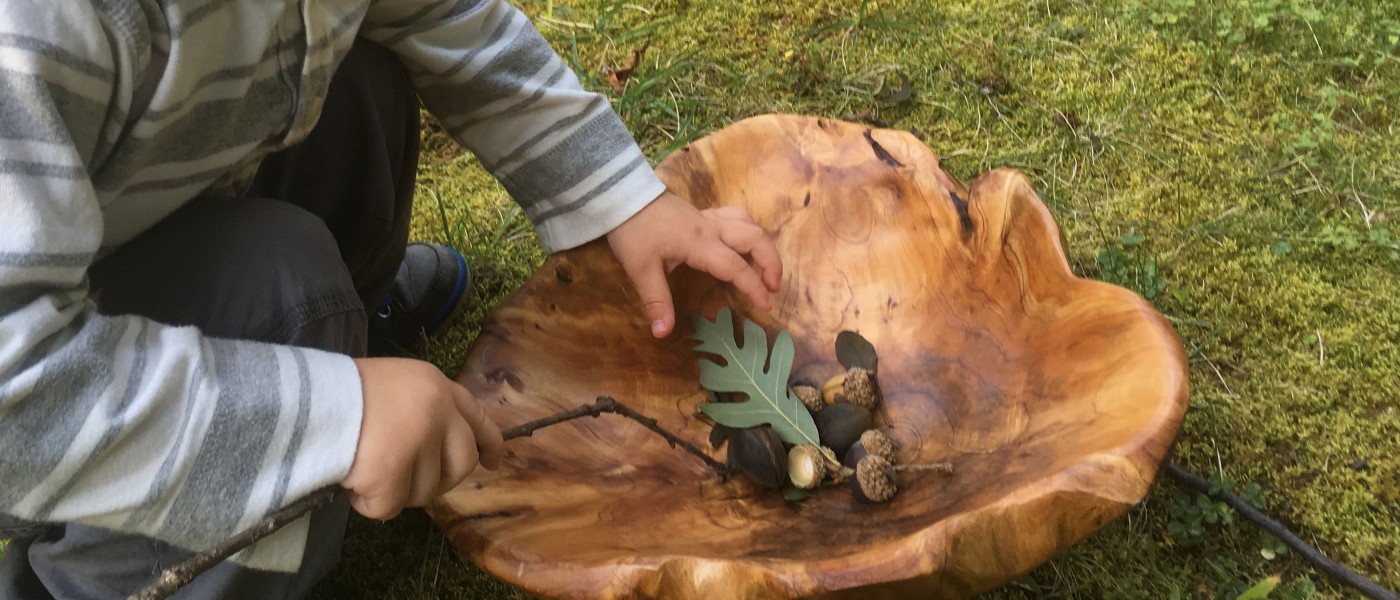Nature Play at Home for Kids of All Abilities
Plants, soil, water, and other natural materials stimulate our senses. This is crucial for young learners, who explore their worlds through observation, touch, smell, taste, and movement.
The Discovery Garden is a special place within Brooklyn Botanic Garden where children can get up close and personal with plants and wildlife. There we have stations and docent-led activities where they can touch, smell, and sometimes taste plants, watch insects, dig in dirt, pour water, listen to bird calls and musical instruments, and more.
We also set aside early morning hours, our Early Openings for Children of All Abilities, when we invite kids and families to the Discovery Garden before it opens to the public. Depending on a child’s age and challenges, we see that learning can involve something sensory, like feeling the endless textures of plants, or imaginative, like pretending to be a bee who smells sweet nectar hidden inside a flower, or something simple like mashing up leaves just to see what will happen.
Studies show that activities that include elements of nature play, free choice, and the use of all five senses can be more accessible to children with disabilities than traditional science classroom learning. These approaches inspire learners of all ages and abilities to get excited about nature at their own pace.
While the Garden is closed, here are some great activities you can do with your children at home. Nature play is fun, messy, smelly, and surprising, and all the while allows the imagination to grow, encourages healthy risk-taking, and builds empathy for all living things.
You don’t need access to a garden—plants are everywhere!
Collect Plant Materials
In the Discovery Garden we often collect clippings, weeds, or plant material like acorns and pinecones from the ground. While at home, you can go on collection walks around your neighborhood. You can collect leaves, petals, tree fruit, rocks, small sticks, and more from the ground. Remember never to take parts off a living plant. Try to collect items from different places along your route instead of from one spot, and take only small amounts. If possible, compost or return natural materials to where you found them once you're done.
If you do not have access to an outdoor space, you can find plants in your own kitchen. We recommend using food scraps before they are composted, such as fruit peels, root vegetables, parts of vegetables that you do not eat, clippings of house plants, bouquets, and dried seeds such as beans, peas, or rice.
Build Your Own Summer Sensory Bin
A sensory bin is typically a large container filled with a selection of materials to engage the senses and encourage open-ended play.
Step 1: Find a large bin.
You can use any bin, like an empty storage container or deep cooking pot. You can fill your sensory bin with any base you’d like. We like using either water, or dry substances like soil, sand, dried beans, and rice. Put down newspaper, a tablecloth, or other material under the bin for easy cleanup.
Step 2: Collect plant parts.
Collect sticks, leaves, flower petals, rocks, leftover plant parts from your kitchen, bouquets, or anything else that reminds you of summer. (Remember to never take anything off a living plant.) Add them to your bin.
Step 3: Add tools!
We like using sponges and bowls for water play, or measuring cups and spoons for digging.
More Ideas
Freeze plant parts into ice cubes or small baking pans the day before. Add the cubes to your water-filled sensory bin and watch them melt, or use tools to chip the ice to get the plant parts out!
If sand or soil is your base, bury your materials underneath and use a paintbrush to gently unearth your treasure.
Make Your Own Instrument
Homemade instruments are fun to make and to play.
Rain Stick
Rain sticks are usually made from dried cacti and their spines, but you can make one at home using recycled materials. You’ll need a toilet paper or paper towel tube, foil, rice, tape, and anything you’d like to decorate with.
Mold a large piece of foil into a spring shape that can fit inside your paper tube. Cover one side of your rain stick with tape, paper, cupcake liners, or more foil. Add rice or small beans. We recommend testing how it sounds before sealing the other side. Decorate with colored tape, stickers, markers, string, feathers, leaves, etc.
Seed Shaker
Using any small container with a cover, fill your seed shaker with various dried beans, rice, or peas. In the Discovery Garden we use small metal tins, but you can use plastic Easter eggs, lidded snack cups, or another small container. Decorate your seed shaker with stickers, colored tape, or ribbons between the container and lid. Experiment with different combinations of seeds to create many sounds!
Throw a Garden Party
Gather up all your toy friends for a garden party!
Use rocks, pieces of branches, blocks, tree cookies, and more as tables, chairs, plates, and cups. Make a natural centerpiece from plants, rocks, or sticks.
We recommend playing music for your party guests.
Make a Nature Play Kitchen
Use any bowl, a little water, and tools for mashing up your plants. Experiment with different plant parts, textures, colors, and scents.
Gather pots, pans, plates, cups, rolling pins, cutting boards, spoons, or any other kitchen supplies. What recipes will you cook in your nature kitchen?
Make Leaf Crowns
Cut a long strip of paper into any crown shape and add small slits along the crown to tuck in leaves, flowers, and other materials. You can also use a tape or stapler to attach the plant parts. Don’t have plants? You can still decorate your crown with other art supplies.
Enjoy your time together, and check bbg.org for more nature projects you can do at home!


